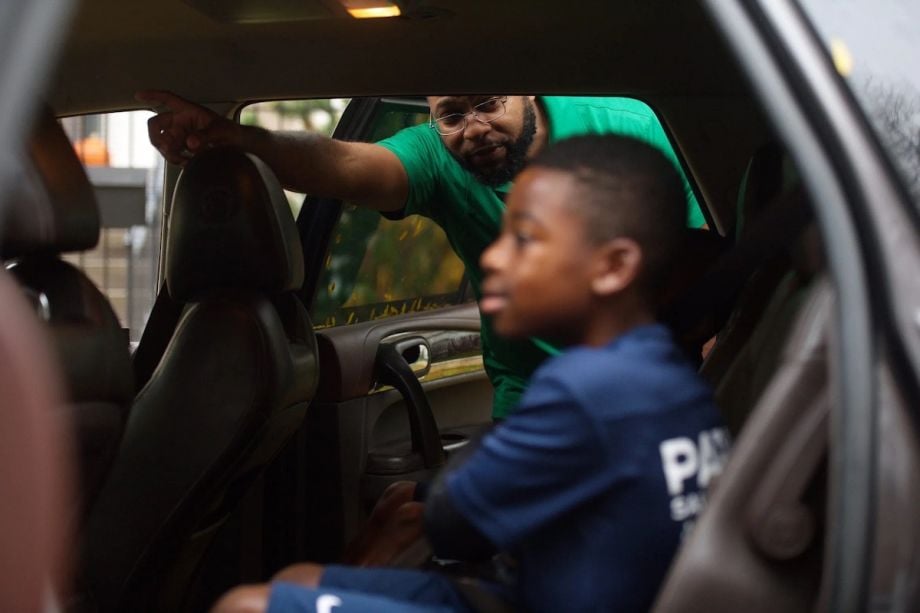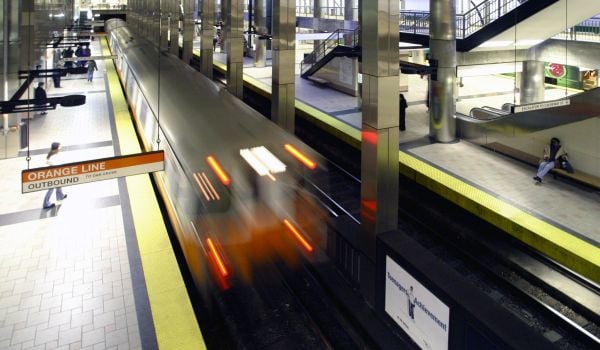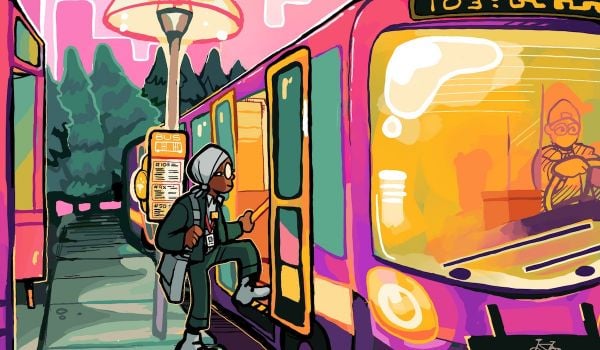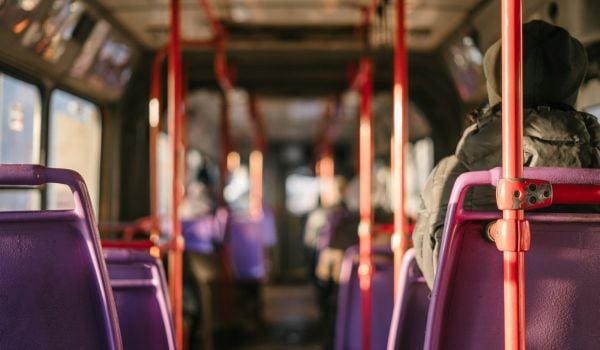This story was originally published by the Illinois Answers Project.
Every weekday at 7:45 a.m., Michael Craft is notified that a rideshare driver has arrived at his home in Aurora, Colorado. Craft walks outside to confirm the driver’s identity and then helps his foster teenager into the car, sending him off to high school about 15 miles away.
The platform he uses, HopSkipDrive, notifies him that the ride has started, and soon he’ll receive another that the teenager has been dropped off. On the network’s app, Craft can track a live mapping of the drive.
“It’s almost overboard but you sit comfortable knowing where your kid is,” Craft said in an interview with the Illinois Answers Project.
He repeats the same process for another foster teen, who attends school in a different district.
HopSkipDrive is a transportation network company designed to take students ages 6 and older to and from school, extracurricular activities and internships. The company works with 600 school districts, nonprofits and government agencies in 14 states plus Washington, D.C.
The company has helped schools grapple with a national shortage of bus drivers by tapping into a driver network of independent contractors.
The bus driver shortage is forcing districts to get creative in finding transportation solutions, including Chicago Public Schools, where officials have had early conversations with HopSkipDrive about the feasibility of bringing the service to Illinois and transporting Chicago students, said Kimberly Jones, executive director of student transportation services for CPS, in an interview with Illinois Answers in November. The state currently requires a school bus permit to transport students, even in passenger cars.
“We’re building the foundation right now” with HopSkipDrive and the state, she said. “We’re just beginning to have those conversations.”
Chicago Public Schools started the 2023-24 school year short of roughly 600 bus drivers, about half needed to transport all students. It has forced the district to prioritize students with disabilities and those experiencing homelessness, which totals to more than 11,700 students who either receive transportation or a monthly stipend, a district spokesperson told Illinois Answers. The district has not been able to provide about 5,500 general, magnet and selective enrollment students with transportation this academic year.
School districts across the country are “all fighting for the same driving population,” Jones said at an October Board of Education about the competition to attract new bus drivers.
CPS has used alternative transportation since 2004 to help fill in the gaps and contracts with eight companies to transport 1,356 students, district officials said. These companies use a variety of vehicles that may require a Commercial Driver’s License or a state-approved school bus driver permit.
However, HopSkipDrive’s independent contractors, called Care Drivers, aren’t required to have an additional license. They drive their personal vehicles and instead undergo a certification process, background and vehicle checks, and must have five years of care-giving experience.
While companies like HopSkipDrive do not solve the need for licensed school bus drivers that many districts hope to hire, it has helped to provide supplemental support and relief for districts.
“We are bringing people from the community – caregivers who are parents, former teachers, nurses, nannies – who don’t want to go through all the requirements to drive a school bus and get their CDL license,” said Joanna McFarland, co-founder and CEO of HopSkipDrive. “Maybe they don’t want a full time job but they are in the community, they are available to help out, and they want flexible ways to make money.”
“We’re taking people from the community that could never contract directly with a district and providing this network of available drivers who have been highly vetted,” she added.
Craft, whose foster children attend schools in three districts, has been using HopSkipDrive for several years. His work as a foster parent would look different without the help of the ride-share company, he said.
“I wouldn’t be able to (foster) the kids I have now if there was no HopSkipDrive,” Craft said. “I would have to take kids based on not their needs, but based on where they go to school and that’s not how you should do that.”
How HopSkipDrive fills the gap
School districts can determine which student populations the network serves and how, McFarland said, including for students with individualized education plans and McKinney-Vento students.
For example, an Indianapolis suburb contracted with the ride-share company last year to take a handful of students experiencing homelessness to and from school. Franklin Township Community School Corporation, a district of nearly 11,000 students, has just enough bus drivers to cover all routes but not to transport students who may be temporarily living several miles outside the district, said Todd Livesay, director of transportation for the district.
“Without a company like HopSkipDrive, you have to go get the kid very early in the morning before all the other routes start,” he said. So a student might be on the bus for over two hours as other students are picked up, or have to wait several hours at school after the other routes are finished.
HopSkipDrive is “just a godsend because they give (students) a quick ride to and from school. It’s safe,” he said. “… I think about my kids and if my kids were in these situations, would I be comfortable? What would I want them to be doing? And I am comfortable,” he said of HopSkipDrive.
“It’s better for the student in the long-run.”
The district pays the company a $19 base fee plus $1.99 per mile, or a $58 minimum, whichever comes first, according to its contract with HopSkipDrive.
Denver Public Schools, a district with 207 schools, uses HopSkipDrive to transport about 250 students to and from school everyday. The service is available to general education students, those who are experiencing homelessness and students with disabilities, said Albert Samora, the district’s executive director of transportation. Denver also uses EverDriven, an alternative model that employs drivers, for about 250 students, he said.
Samora said the district initially used HopSkipDrive and other alternative transportation services for inefficient routes, or routes outside the district for students in foster care or who don’t have permanent housing. But amid the bus driver shortage, the district has turned to these companies for other routes.
“HopSkipDrive and EverDriven and other contractors have become a side-by-side solution when we don’t have the drivers,” he said. “So now they’ve moved from being a supplemental service to being almost part of our primary service.”
Over the last several years, he said the district has been working to close the gap by, in part, increasing bus driver wages and offering bonuses. Samora said this has helped reduce the shortage from 100 bus drivers in 2019 to roughly 40 this academic year.
Samora said the alternative services make up about a third of the district’s $30 million transportation budget. For comparison, Chicago Public Schools has a $146 million transportation budget and spends about $7 million on alternative services for companies to transport over 1,000 students, a district spokesperson said.
Denver has been using HopSkipDrive since 2021, according to its contract, and currently employs 160 bus drivers, said Tyler Maybee, director of operations. A HopSkipDrive ride costs $2.99 per mile plus a $19 base fee for each ride, according to Denver’s contract with the service, obtained through a public records request.
Denver Public Schools, with nearly 90,000 students, and Virginia Fairfax County Public Schools, with nearly 180,000 students, are the largest districts that HopSkipDrive serves, McFarland said. CPS, for comparison, has over 320,000 students in the district.
A local option
While CPS provides CTA Ventra cards for the 5,500 magnet and selective enrollment students and gives a monthly stipend of up to $500 to eligible diverse learners and students in temporary living situations, the rest of students must find transportation on their own.
Maria Ugarte’s child does not qualify for district transportation, so she or her husband drive her daughter – and three other children in a carpool – 45 minutes one way to Inter-American Elementary Magnet School in Lakeview, she said.
Ugarte, who serves on the Local School Council, worries that the lack of transportation, especially for low income families, will impact enrollment at her child’s dual-language school. As an immigrant, she said, it’s important for her children to maintain their heritage.
She said she’d be hesitant to use HopSkipDrive because she’s not familiar with how drivers are vetted.
“My daughter is 12. … My kids don’t walk anywhere on their own, so I don’t think I’d be able to put them in a car where I’m not 100% sure that everything has been checked for those drivers,” she said. “… At this moment, I don’t feel comfortable because it’s something so new.”
CPS parent Ismael El-Amin’s eldest two children also didn’t qualify for transportation because they are in selective enrollment schools and live about 8 and 17 miles away. In 2021, he co-founded a carpool service called PiggyBack Network that connects parents by matching routes to school or other activities.
El-Amin said he founded the company because he understands how the lack of reliable transportation can hinder future opportunities. When he was in junior high school, he had to take a CTA bus to football practice and would arrive late. His coach discovered that El-Amin lived nearby and began taking him to practice.
“That led to being a leader in high school, that led to being recruited to play football in college and just changed the trajectory of my life,” El-Amin said. “I’m sensing how one person’s sacrifice changed my complete trajectory.”
PiggyBack has already partnered with the YMCA of Metropolitan Chicago to provide rides for some of its day camps last summer, for example, and operates in a handful of cities including Atlanta, Miami and Boston, he said. CPS has reached out to PiggyBack for information for a potential partnership, both El-Amin and the district said.
“You may not know each other, you may not even go to the same school, you might overlap and go to a school two blocks away, but PiggyBack is going to say, ‘family A, you all should talk to family B’,” El-Amin said.
There’s a screening process where families meet before carpooling and drivers undergo a background check.
To pay for rides, parents buy points based on mileage and time. Depending on peak times, families can expect to pay a base fee up to $4, between 32 and 75 cents per mile, or up to $5 per hour. The family that requests the ride pays with points and the drivers gain points when they complete rides. PiggyBack keeps a portion of the sale, he said.
There is no direct payout for drivers, he said, in order to ensure it’s a true carpool. Instead, drivers can use points to pay for rides for their children.
Jazmine Dillard, a pediatric dentist, learned about PiggyBack from other parents last summer after she found out that her second-grade son would no longer qualify for busing. She needs help in the mornings dropping off two of her sons and was able to match with El-Amin, who takes a similar route to his daughter’s school. El-Amin said the stop only adds five minutes to his commute.
After being matched, they quickly discovered that Dillard’s husband and El-Amin both graduated from Whitney Young High School. Although strangers, that sense of familiarity and understanding of values is what sold Dillard to use PiggyBack, she said.
“I’m praying that this works for a long period of time because there are very few (transportation) programs dedicated for children,” Dillard said. “… What made me most comfortable was that (PiggyBack) vets their drivers. I don’t want to just put my kid in an Uber with some random person. … I felt very comfortable and reassured once I heard about how they went about their process of finding drivers.”
Could HopSkipDrive operate in Chicago?
The main challenge in bringing HopSkipDrive to Chicago starts with the state.
Currently, Illinois Vehicle Code requires drivers who transport students to obtain a school bus permit, even in passenger vehicles, which can carry up to 10 people. To obtain a permit, a driver must pass a written and driving test, health exam, training course, and a criminal background check, among other requirements.
A spokesperson for HopSkipDrive told Illinois Answers that these regulations “don’t make sense” for their CareDrivers.
“In Illinois, the regulations require someone on our platform to follow essentially the same requirements of driving a 12-ton school bus,” according to a statement from the company. “… CareDrivers are driving a few hours a week, driving students just seven to eight trips a week on average, in a traditional sedan vehicle with one to three kids.”
The company supports a bill introduced in the Illinois House last year that would reclassify vehicles that are allowed to transport students and allow the Secretary of State to offer a separate permit for passenger vehicles. State Rep. Jaime Andrade (Democrat, district 40), who introduced HB 3476, did not respond to multiple requests for comment.
There is precedent for states to change laws to accommodate HopSkipDrive.
In 2022 in Missouri, for example, legislators changed restrictions to allow vehicles other than school buses to transport students and repealed a requirement that drivers of these vehicles need a school bus driver’s license, among other changes.
The same year, Colorado’s governor signed legislation that allowed the state’s Public Utilities Commission to regulate HopSkipDrive like other transportation networks. Opponents of the bill, which included competing bus driver companies and advocates for children with disabilities, argued that HopSkipDrive wouldn’t be held to the same safety standards since they are not only overseen by school districts, according to local media reports.
Wherever they operate, the ride-share company is also subject to city requirements for transportation network providers. In Chicago, requirements include having signage about 311 call information and providing up-front pricing to customers.
Given the vastness of Chicago Public Schools, HopSkipDrive may be more financially reasonable and equitable for districts with a smaller student population, said P.S. Sriraj, director of the Urban Transportation Center at the University of Illinois Chicago, in an interview with Illinois Answers.
But if CPS were to partner with the network, he recommended that district leaders test it on a small scale to fully evaluate how it could be used. The district should thoroughly communicate and make decisions with the input from parents, students and teachers, he added.
In the meantime, to attract and retain bus drivers to keep up with increasing transportation requests, CPS has increased wages by $5 over the last two years and is planning 15 hiring fairs, Jones said in October. The district is also trying to optimize routes to make sure they’re efficient, and is working with the Secretary of State to reduce the requirements to be a bus driver.
“We are looking at all variables when it comes to alternative modes of transportation so we’re not just restricted to the school buses,” Jones told the Illinois Answer Project.
Companies like HopSkipDrive may be a step in that direction.
“Private companies in the world of student transportation is not new,” McFarland said.
What has changed, she said, is that students are no longer going to their neighborhood school.
“There are magnet schools, schools of choice, and a lot more individualized needs. The idea of 70 kids sitting on a school bus route isn’t really reality in a lot of cases,” she said. “And so we need to think about giving districts the tools and the flexibility to solve the problems of this growing and individualized student body in ways that best meet their needs. I think of us as a tool in the district’s toolkit.”
Jewél Jackson is a multimedia investigative reporter who focuses on K-12 and higher education for the Illinois Answers Project. She has covered higher education for El Paso Matters in El Paso, Texas and various social justice movements in her hometown of Louisville, Kentucky. Jackson has produced numerous radio segments for local National Public Radio stations and is an alumna of the S.I. Newhouse School of Public Communications at Syracuse University.
















